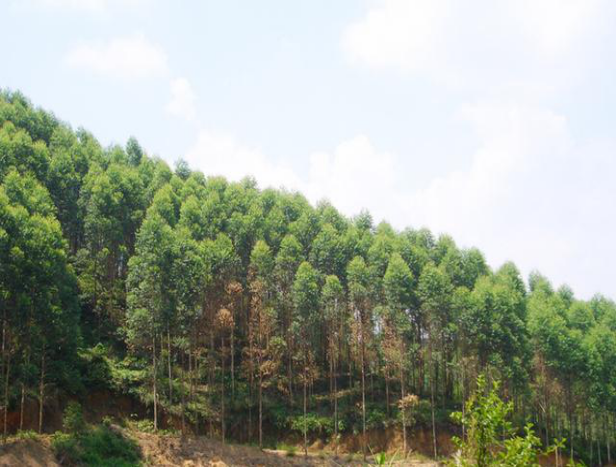 PDF(1510 KB)
PDF(1510 KB)


Analysis of comprehensive benefits and influencing factors based on the combined economic value of carbon sequestration and timber benefits
XUE Beibei, TIAN Guoshuang
Journal of Nanjing Forestry University (Natural Sciences Edition) ›› 2021, Vol. 45 ›› Issue (2) : 205-212.
 PDF(1510 KB)
PDF(1510 KB)
 PDF(1510 KB)
PDF(1510 KB)
Analysis of comprehensive benefits and influencing factors based on the combined economic value of carbon sequestration and timber benefits
【Objective】This study aimed to explore the optimal forest management for combined carbon sequestration benefits and timber values and provide a theoretical basis for improving the comprehensive benefits of forests.【Method】Based on the forest management cost data and harvest carbon model of Chinese fir and eucalyptus in the Shunchang County State-owned Forest Farm of Fujian Province, a modified Faustmann-Hartman model was used to predict the effects of forest management costs, carbon sequestration benefits, timber value, and interest rate fluctuation on optimal forest economic value.【Result】Under the existing conditions of constant forest management cost and management intensity, multiple-benefit management involving carbon sequestration may improve the optimal forest economic value, suggesting that the carbon market has certain investment benefits. If the silvicultural cost fluctuates from -40% to 40%, the comprehensive benefits of Chinese fir and eucalyptus will decrease from 40 402.33 to 5 599.02 yuan/hm2 and 51 521.61 to 15 530.34 yuan/hm2, respectively, and the rotation period of the two tree species will extend for two years. When the timber price increases from null to 500 yuan/hm2, the comprehensive benefits of Chinese fir and eucalyptus will increase from 21 423.52 to 34 209.48 yuan/hm2 and 25 845.13 to 92 644.11 yuan/hm2, respectively. The optimal rotation period of Chinese fir will remain at 20 years; however, that of eucalyptus will decrease from 8 years to 6 years, being associated with rising timber prices. When the interest rate increases from 1% to 7%, the comprehensive benefit of Chinese fir will decrease from 383 745.32 to 890.14 yuan/hm2, and its optimal rotation period will be shortened by 6 years. With the same interest rate change, the comprehensive benefits of eucalyptus will decrease from 254 648.72 to 16 728.99 yuan/hm2, and its optimal rotation period will be shortened by one year. 【Conclusion】Carbon sequestration benefits and timber prices positively affect the comprehensive benefits of Chinese fir and eucalyptus, whereas interest rate and silvicultural cost have a negative impact. The sensitivity and order of the comprehensive benefits of Chinese fir and eucalyptus to the various economic factors differ; in terms of forest comprehensive benefits, eucalyptus is better than Chinese fir; however, the reverse is true in response to climate change.

carbon sequestration benefits / timber benefits / Faustmann-Hartman model / comprehensive benefits of forest land / Chinese fir / eucalyptus
| [1] |
简盖元, 冯亮明, 刘伟平. 基于碳汇价值的森林最优轮伐期分析[J]. 林业经济问题, 2011,31(1):70-75.
|
| [2] |
|
| [3] |
|
| [4] |
|
| [5] |
|
| [6] |
|
| [7] |
|
| [8] |
|
| [9] |
|
| [10] |
朱臻, 沈月琴, 张耀启, 等. 碳汇经营目标下的林地期望价值变化及碳供给:基于杉木裸地造林假设研究[J]. 林业科学, 2012,48(11):112-116.
|
| [11] |
朱臻, 沈月琴, 吴伟光, 等. 碳汇目标下农户森林经营最优决策及碳汇供给能力:基于浙江和江西两省调查[J]. 生态学报, 2013,33(8):2577-2585.
|
| [12] |
沈月琴, 王枫, 张耀启, 等. 中国南方杉木森林碳汇供给的经济分析[J]. 林业科学, 2013,49(9):140-147.
|
| [13] |
沈月琴, 王小玲, 王枫, 等. 农户经营杉木林的碳汇供给及其影响因素[J]. 中国人口·资源与环境, 2013,23(8):42-47.
|
| [14] |
王小玲, 沈月琴, 朱臻. 考虑碳汇收益的林地期望值最大化及其敏感性分析:以杉木和马尾松为例[J]. 南京林业大学学报(自然科学版), 2013,37(4):143-148.
|
| [15] |
林卓, 吴承祯, 洪伟, 等. 杉木人工林碳汇木材复合经济收益分析及最优轮伐期确定:基于时间序列预测模型[J]. 林业科学, 2016,52(10):134-145.
|
| [16] |
侯元兆, 吴水荣. 森林生态服务价值评价与补偿研究综述[J]. 世界林业研究, 2005 (3):1-5.
|
| [17] |
陈幸良, 巨茜, 林昆仑. 中国人工林发展现状、问题与对策[J]. 世界林业研究, 2014,27(6):54-59.
|
| [18] |
邹国明. 发展桉树速丰林是增加碳汇的有效途径——桉树在漳州市的可持续发展[C]// 2010中国科协年会第五分会场全球气候变化与碳汇林业学术研讨会优秀论文集.福州, 2010.
|
| [19] |
|
| [20] |
|
| [21] |
朱臻, 沈月琴, 白江迪. 南方集体林区林农的风险态度与碳汇供给决策:一个来自浙江的风险偏好实验[J]. 中国软科学, 2015(7):148-157.
|
| [22] |
刘俊昌. 林业经济学[M].2版. 北京: 中国农业出版社, 2011.
|
| [23] |
王周绪, 姜全飞. 中国林业行业基准贴现率研究[J]. 林业经济, 2006(6):39-44.
|
| [24] |
王永闽. 福建山区桉树短周期工业原料林经营效益研究[D]. 南京:南京林业大学, 2007.
|
| [25] |
黄宰胜, 陈钦. 基于造林成本法的林业碳汇成本收益影响因素分析[J]. 资源科学, 2016,38(3):485-492.
|
| [26] |
|
| [27] |
陈则生. 杉木人工林经济成熟龄的研究[J]. 林业经济问题, 2010,30(1):22-26.
|
| [28] |
文娟, 金大刚, 莫祝平, 等. 不同造林模式人工林碳贮量的预估及比较分析:以广西西北部地区退化土地再造林项目为例[J]. 广西林业科学, 2009,38(1):35-38.
|
| [29] |
辛姜, 赵春艳. 中国碳排放权交易市场波动性分析:基于MS-VAR模型[J]. 软科学, 2018,32(11):134-137.
|
| [30] |
胡雪凡, 张会儒, 张晓红. 中国代表性森林经营技术模式对比研究[J]. 森林工程, 2019,35(4):32-38.
|
| [31] |
张云. 中国碳交易价格驱动因素研究:基于市场基本面与政策信息的双重视角[J]. 社会科学辑刊, 2018(1):111-120.
|
| [32] |
黄宰胜, 陈钦. 不同情境下桉树碳汇林最佳轮伐期分析[J]. 长江流域资源与环境, 2016,25(S1):25-31.
|
| [33] |
高沁怡, 潘春霞, 刘强, 等. 基于贝叶斯网络的林业碳汇项目风险评价[J/OL]. 南京林业大学学报(自然科学版):1-12[2020-09-17]. http://kns.cnki.net/kcms/detail/32.1161.s.20200415.1701.004.html
|
| [34] |
田琪, 柯水发, 杜欣, 等. 我国林业碳汇供给意愿的影响因素分析——基于湖北省太子山林场的实证调查[J]. 生态经济(学术版), 2013(2):168-172.
|
| [35] |
姜启功, 姜雷, 封磊, 等. 连云港南云台林场森林可持续经营技术探讨[J]. 江苏林业科技, 2020,47(6):50-56.
|
/
| 〈 |
|
〉 |